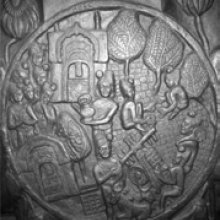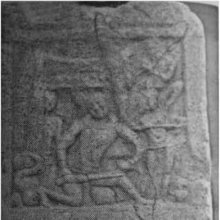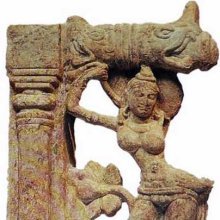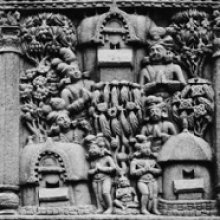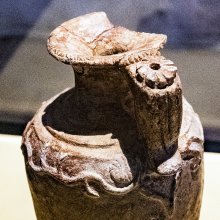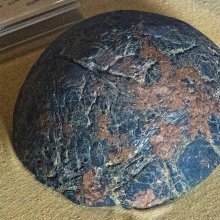Jetavana, Jeta-vana: 8 definitions
Introduction:
Jetavana means something in Buddhism, Pali, Hinduism, Sanskrit, the history of ancient India. If you want to know the exact meaning, history, etymology or English translation of this term then check out the descriptions on this page. Add your comment or reference to a book if you want to contribute to this summary article.
Images (photo gallery)
(+2 more images available)
In Buddhism
Theravada (major branch of Buddhism)
Source: Pali Kanon: Pali Proper Names1. Jetavana - A park in Savatthi, in which was built the Anathapindikarama. When the Buddha accepted Anathapindikas invitation to visit Savatthi the latter, seeking a suitable place for the Buddhas residence, discovered this park belonging to Jetakumara (MA.i.471 says it was in the south of Savatthi). When he asked to be allowed to buy it, Jetas reply was: Not even if you could cover the whole place with money. Anathapindika said that he would buy it at that price, and when Jeta answered that he had had no intention of making a bargain, the matter was taken before the Lords of Justice, who decided that if the price mentioned were paid, Anathapindika had the right of purchase. Anathapindika had gold brought down in carts and covered Jetavana with pieces laid side by side. (This incident is illustrated in a bas relief at the Bharhut Tope; see Cunningham - the Stupa of Bharhut, Pl.lvii., pp.84-6). The money brought in the first journey was found insufficient to cover one small spot near the gateway. So Anathapindika sent his servants back for more, but Jeta, inspired by Anathapindikas earnestness, asked to be allowed to give this spot. Anathapindika agreed and Jeta erected there a gateway, with a room over it. Anathapindika built in the grounds dwelling rooms, retiring rooms, store rooms and service halls, halls with fireplaces, closets, cloisters, halls for exercise, wells, bathrooms, ponds, open and roofed sheds, etc. (Vin.ii.158f).
It is said (MA.i.50; UdA.56f) that Anathapindika paid eighteen crores for the purchase of the site, all of which Jeta spent in the construction of the gateway gifted by him. (The gateway was evidently an imposing structure; see J.ii.216).
Jeta gave, besides, many valuable trees for timber. Anathapindika himself spent fifty four crores in connection with the purchase of the park and the buildings erected in it.
The ceremony of dedication was one of great splendour. Not only Anathapindika himself, but his whole family took part: his son with five hundred other youths, his wife with five hundred other noble women, and his daughters Maha Subhadda and Cula Subhadda with five hundred other maidens. Anathapindika was attended by five hundred bankers. The festivities in connection with the dedication lasted for nine months (J.i.92ff).
Some of the chief buildings attached to the Jetavana are mentioned in the books by special names, viz., Mahagandhakuti, Kaverimandalamala, Kosambakuti and Candanamala. SNA.ii.403. Other buildings are also mentioned - e.g., the Ambalakotthaka asanasala (J.ii.246). According to Tibetan sources the vihara was built according to a plan sent by the devas of Tusita and contained sixty large halls and sixty small. The Dulva also gives details of the decorative scheme of the vihara (Rockhill: op. cit.48 and n.2).
Theravāda is a major branch of Buddhism having the the Pali canon (tipitaka) as their canonical literature, which includes the vinaya-pitaka (monastic rules), the sutta-pitaka (Buddhist sermons) and the abhidhamma-pitaka (philosophy and psychology).
Mahayana (major branch of Buddhism)
Source: Wisdom Library: Maha Prajnaparamita SastraJetavana (जेतवन) or Jetavanavihāra is the name of a stoppig-place, or vihāra located at Śrāvastī, according to the 2nd century Mahāprajñāpāramitāśāstra chapter V. Note: The Jetavana-vihāra (Tche houan tsing chö) was offered to the Buddha by Anāthapiṇḍada who had first bought it from its owned, Jeta, for the price of its surface covered in pieces of gold. The story of the gift is in the Vinaya, II; Wou fen liu; Sseu fen liu; Che song liu; Ken pen chouo… p’o seng che; Nidānakathā.
Jetavana-vihāra is represented at Sāncī (north toraṇa, left abutment), at Bhārhut, at Gandhāra. The Buddha stayed there for nineteen varṣas (Dhammapadaṭṭha, I) and, when the Mṛgāramātṛprāsāda was built, he stayed at Jetavana and at Mṛgāramātṛptāsāda alternately, spending the day at one and the night at the other (Suttanipāta Commentary, I). The Jetavana was visited by Fa hien and Hiuan tsang who found it in ruins.

Mahayana (महायान, mahāyāna) is a major branch of Buddhism focusing on the path of a Bodhisattva (spiritual aspirants/ enlightened beings). Extant literature is vast and primarely composed in the Sanskrit language. There are many sūtras of which some of the earliest are the various Prajñāpāramitā sūtras.
India history and geography
Source: archive.org: Ceylon Branch of the Royal Asiatic Society 1963Jetavana or Jetavanavihāra is the name of an ancient temple complex situated within the city of Anurādhapura.—The Jetavana-vihāra, also called Denānaka or Denā-vihāra in Sinhalese inscriptions and literature, was founded by Mahāsena (275-301) in the Jotivana Park on territory within the precincts of the Mahāvihāra. The king built it for the Mahāthera of Dakkhiṇa-vihāra. The Jetavanārāma monks were of the Sāgaliya sect which first established itself at Dakkhiṇa-vihāra in the year 253.
Source: Ancient Buddhist Texts: Geography of Early BuddhismJetavana (जेतवन) is the name of a forest situated in Majjhimadesa (Middle Country) of ancient India, as recorded in the Pāli Buddhist texts (detailing the geography of ancient India as it was known in to Early Buddhism).—The Jetavana is frequently mentioned in Pāli literature. In the Dīgha Nikāya we are told that once the Buddha dwelt at Jetavana in the pleasure garden of Anāthapiṇḍika at Sāvatthī. There the Buddha spoke on the subject of right training to Poṭṭhapāda, the wanderer. The Jetavana is one mile to the south of Sāvatthī which is identified with modern Sahet-Maheth. It was a gift from the merchant named Anāthapiṇḍika to the Buddha and the Order.

The history of India traces the identification of countries, villages, towns and other regions of India, as well as mythology, zoology, royal dynasties, rulers, tribes, local festivities and traditions and regional languages. Ancient India enjoyed religious freedom and encourages the path of Dharma, a concept common to Buddhism, Hinduism, and Jainism.
Languages of India and abroad
Sanskrit dictionary
Source: Cologne Digital Sanskrit Dictionaries: Edgerton Buddhist Hybrid Sanskrit DictionaryJetavana (जेतवन).—(normally) nt., rarely m. (= Pali id.), name of the grove at Śrāvastī where Buddha often dwelt and preached: Mahāvastu i.4.13; 27.11; 29.13; 30.11; 31.9; 32.14; 33.8; 73.3; iii.224.11; Mahāvyutpatti 4112, °nam; Lalitavistara 1.5; 4.14 (here masc., sarvāvantaṃ °vanaṃ, acc.); Divyāvadāna 1.2 etc.; 80.12; Avadāna-śataka i.13.5 etc.; also in verse, the two parts separated, Jeta- sāhvayaṃ vanaṃ Lalitavistara 7.4 (verse), the grove called Jeta.
Source: Cologne Digital Sanskrit Dictionaries: Monier-Williams Sanskrit-English DictionaryJetavana (जेतवन):—[=jeta-vana] [from jeta] n. ‘Jetri’s wood’, Name of a grove near Śrāvastī (where Buddha promulgated his doctrines), [Buddhist literature]
[Sanskrit to German]
Sanskrit, also spelled संस्कृतम् (saṃskṛtam), is an ancient language of India commonly seen as the grandmother of the Indo-European language family (even English!). Closely allied with Prakrit and Pali, Sanskrit is more exhaustive in both grammar and terms and has the most extensive collection of literature in the world, greatly surpassing its sister-languages Greek and Latin.
See also (Relevant definitions)
Starts with: Jetavana-thupa, Jetavanaloka, Jetavanarama, Jetavanavihara.
Full-text (+220): Jetavanavihara, Jetarama, Jetasahvaya, Jetri, Mahamanikagama, Shravasti, Anathapindikassarama, Jetuyyana, Gandhakuti, Jotivana, Kosambakuti, Kurundacullaka, Titthiyarama, Jetavaniya, Manakama Sutta, Uttarasailah, Ambala, Apagata Sutta, Cetoparicca Sutta, Sadhu Sutta.
Relevant text
Search found 39 books and stories containing Jetavana, Jeta-vana; (plurals include: Jetavanas, vanas). You can also click to the full overview containing English textual excerpts. Below are direct links for the most relevant articles:
The Jataka tales [English], Volume 1-6 (by Robert Chalmers)
Jataka 462: Saṃvara-jātaka < [Volume 4]
Jataka 75: Maccha-jātaka < [Book I - Ekanipāta]
Jataka 229: Palāyi-jātaka < [Book II - Dukanipāta]
Dhammapada (Illustrated) (by Ven. Weagoda Sarada Maha Thero)
Verse 306 - The Story of Sundarī the Wandering Female Ascetic < [Chapter 22 - Niraya Vagga (Hell)]
Verse 176 - The Story of Cincāmānavikā < [Chapter 13 - Loka Vagga (World)]
Verse 268-269 - The Story of the Followers of Non-Buddhist Doctrines < [Chapter 19 - Dhammaṭṭha Vagga (Established in Dhamma)]
Bihar and Eastern Uttar Pradesh (early history) (by Prakash Narayan)
Gahapatis and Kings < [Chapter 4 - Social Process, Structures and Reformations]
Gahapatis and Brahmanas < [Chapter 4 - Social Process, Structures and Reformations]
The Pattern of Landholding < [Chapter 2 - Economic and Urban Processes]
Vinaya (3): The Cullavagga (by T. W. Rhys Davids)
Cullavagga, Khandaka 6, Chapter 9 < [Khandaka 6 - On Dwellings and Furniture]
Cullavagga, Khandaka 5, Chapter 22 < [Khandaka 5 - On the Daily Life of the Bhikkhus]
Cullavagga, Khandaka 3, Chapter 1 < [Khandaka 3 - Probation And Penance (B)]
The travels of Fa-Hian (400 A.D.) (by Samuel Beal)
The Great Chronicle of Buddhas (by Ven. Mingun Sayadaw)
Chapter 34d - The Buddha’s Twentieth Vassa at Rājagaha < [Volume 4]
Chapter 19b - The Buddha’s Second Vassa < [Volume 3]
Biography (7) (Bahuputtika) Soṇā Therī < [Chapter 44 - Life Histories of Bhikkhunī Arahats]
